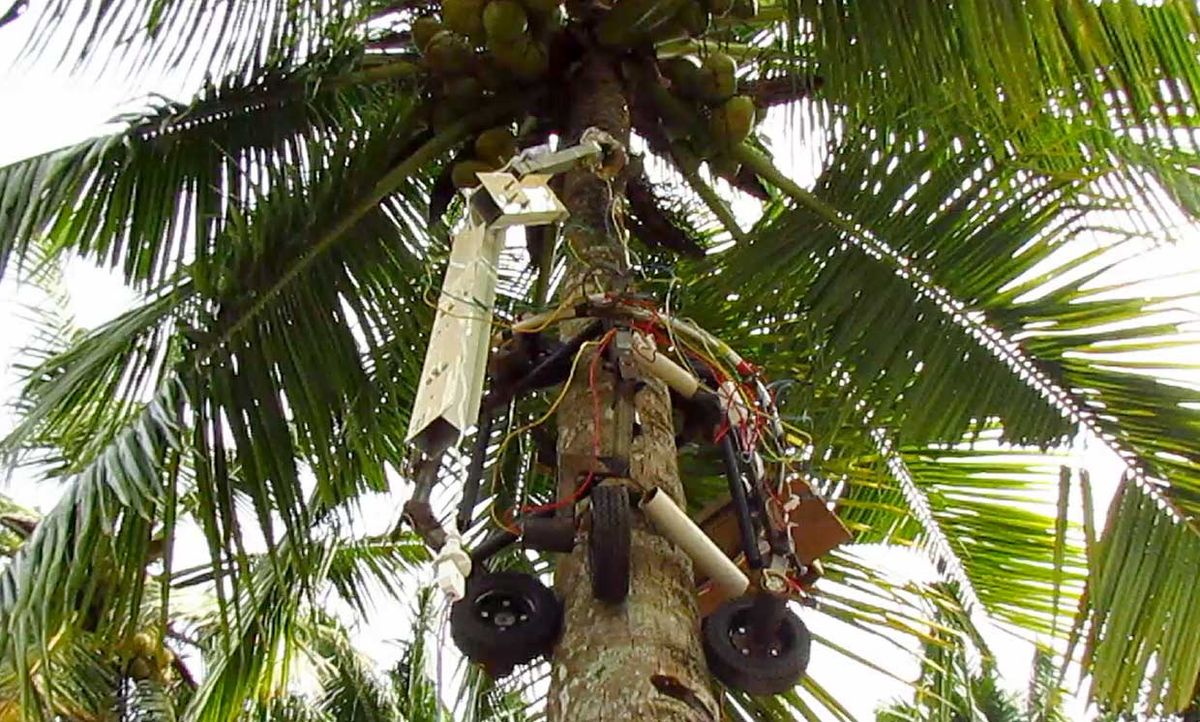Coconuts may be delicious and useful for producing a wide range of products, but harvesting them is no easy task. Specially trained harvesters must risk their lives by climbing trees roughly 15 meters high to hack off just one bunch of coconuts. A group of researchers in India has designed a robot, named Amaran, that could reduce the need for human harvesters to take such a risk. But is the robot up to the task?
The researchers describe the tree-climbing robot in a paper published in the latest issue of IEEE/ASME Transactions on Mechatronics. Along with lab tests, they compared Amaran’s ability to harvest coconuts to that of a 50-year-old veteran harvester. Whereas the man bested the robot in terms of overall speed, the robot excelled in endurance.
To climb, Amaran relies on a ring-shaped body that clasps around trees of varying diameter. The robot carries a control module, motor drivers, a power management unit, and a wireless communications interface. Eight wheels allow it to move up and down a tree, as well as rotate around the trunk. Amaran is controlled by a person on the ground, who can use an app or joystick system to guide the robot’s movements.
Once Amaran approaches its target, an attached controller unit wields a robotic arm with 4 degrees of freedom to snip the coconut bunch. As a safety feature, if Amaran’s main battery dies, a backup unit kicks in, helping the robot return to ground.
Rajesh Kannan Megalingam, an assistant professor at Amrita Vishwa Vidyapeetham University, in South India, says his team has been working on Amaran since 2014. “No two coconut trees are the same anywhere in the world. Each one is unique in size, and has a unique alignment of coconut bunches and leaves,” he explains. “So building a perfect robot is an extremely challenging task.”
While testing the robot in the lab, Megalingam and his colleagues found that Amaran is capable of climbing trees when the inclination of the trunk is up to 30 degrees with respect to the vertical axis. Megalingam says that many coconut trees, especially under certain environmental conditions, grow at such an angle.
Next, the researchers tested Amaran in the field, and compared its ability to harvest coconuts to the human volunteer. The trees ranged from 6.2 to 15.2 m in height.
It took the human on average 11.8 minutes to harvest one tree, whereas it took Amaran an average of 21.9 minutes per tree (notably 14 of these minutes were dedicated to setting up the robot at the base of the tree, before it even begins to climb).

But Megalingam notes that Amaran can harvest more trees in a given day. For example, the human harvester in their trials could scale about 15 trees per day before getting tired, while the robot can harvest up to 22 trees per day, if the operator does not get tired. And although the robot is currently teleoperated, future improvements could make it more autonomous, improving its climbing speed and harvesting capabilities.
“Our ultimate aim is to commercialize this product and to help the coconut farmers,” says Megalingam. “In Kerala state, there are only 7,000 trained coconut tree climbers, whereas the requirement is about 50,000 trained climbers. The situation is similar in other states in India like Tamil Nadu, Andhra, and Karnataka, where coconut is grown in large numbers.”
He acknowledges that the current cost of the robot is a barrier to broader deployment, but notes that community members could pitch together to share the costs and utilization of the robot. Most importantly, he notes, “Coconut harvesting using Amaran does not involve risk for human life. Any properly trained person can operate Amaran. Usually only male workers take up this tree climbing job. But Amaran can be operated by anyone irrespective of gender, physical strength, and skills.”
Michelle Hampson is a freelance writer based in Halifax. She frequently contributes to Spectrum's Journal Watch coverage, which highlights newsworthy studies published in IEEE journals.



